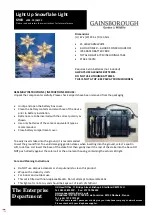
TrinityHighway.com
44
Revision C September 2021
Post-Impact Instructions
1) Deploy the appropriate traffic-control devices to protect your crew.
Warning:
An impacted system can store energy in collapsed Cylinders and
may
spring back unexpectedly
causing serious injury. Use caution during post-impact
inspections for repair or refurbishment.
Warning:
It is the responsibility of the
worker to keep hands and other body
parts clear of system interaction. Be aware of tools (pry bar, etc.) that could move
unexpectedly if a bind is suddenly released.
2) P
osition a minimum 1-ton p i c k u p truck on the system just in front of the Nose
Assembly. Place the truck bumper against the system. The truck bumper height,
approximately 24” [610 mm], should rest against the middle center of the Nose
Assembly.
Warning:
Once the bumper is over the system’s Monorail, the vehicle may be
subject to pushing force due to unexpected restoration. The driver should be
wearing a seat belt and have the vehicle in the lowest possible gear when
approaching the system. In the event the system unexpectedly deploys before
Step 2 is complete, the driver should apply the brakes immediately to bring the
vehicle to a controlled stop. The vehicle must be in neutral while still applying the
brakes and then gradually release the brakes to allow the system to restore against
the truck bumper in a safe and controlled way.
3) Once the truck is in place, carefully move the truck so the bumper displaces the Nose
Cylinder 6”. In the absence of the Nose assembly, place protective material between the
bumper and the first Diaphragm leaving a 1.00” gap between the protective material and
the truck bumper. It is the responsibility of the driver to remain in the vehicle to apply the
brake during initial system displacement.
Caution:
Use a pry bar with a 1-ton truck to release additional mechanical binds
in a safe and controlled manner.
4) Wrap a chain, 3/8”X20’ Grade 40 minimum, around the first Diaphragm (Figure 42). Attach
both ends of chain to truck bumper anchor points.
Important:
Wrap chain around the first
Diaphragm so the pull force is aligned with the
long slots in the Fender Panels to ensure a
smoother extension.
Warning:
Stand clear in case chain breaks or
becomes disconnected.
Important:
Have someone watch during
repositioning to ensure undetected damage
does not cause the Diaphragms to bind or pull
out improperly. Wait ten minutes after full
extension for Cylinders to regain their former
shape.
Figure 41
Attach Chain to First Diaphragm
FIRST DIAPHRAGM
Summary of Contents for QuadGuard Elite M10
Page 1: ......
Page 11: ...TrinityHighway com 10 Revision C September 2021 ME3 Cylinder Assembly 618702...
Page 49: ...TrinityHighway com 48 Revision C September 2021 QuadGuard Elite M10 QGEMTSCVR U Drawings...
Page 50: ...TrinityHighway com 49 Revision C September 2021 TS Concrete Pad 618686...
Page 51: ...TrinityHighway com 50 Revision C September 2021 TS Concrete Pad 8 w Rebar 618686...
Page 52: ...TrinityHighway com 51 Revision C September 2021 TS Concrete Pad 8 wo Rebar 618686...
Page 55: ...TrinityHighway com 54 Revision C September 2021 Thrie Beam Transition QGEMTSCVR TTLR...
Page 56: ...TrinityHighway com 55 Revision C September 2021 End Shoe Transition QGEMTSCVR ESLR...
Page 57: ...TrinityHighway com 56 Revision C September 2021 Extended End Shoe Transition QGEMTSCVR SPE...
Page 58: ...TrinityHighway com 57 Revision C September 2021 31 W Beam Transition QGEMTSCVR TWLR...
Page 59: ...TrinityHighway com 58 Revision C September 2021 Notes...
Page 60: ......
















































